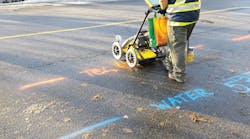CGA and NTDPC Work to Prevent Them
In March 2016, infrastructure damage stemming from a fiber installation was reported. Earlier in the year, it was announced that fiber installations would soon begin in an attempt to bring a 1-gigabit network of fiber optic cables to the city. The network, over 100 times faster than your typical broadband, captured the attention of residents as they prepared for the construction.
The installation of such cables in the city had previously led to a few problems, but none as debilitating as the one that occurred in March. An excavator working for the company hit a water main, causing the knocking out of 18 meters of water along with 5 fire hydrants. Those affected by the resulting damage included a nearby Montessori school that had to request all students vacate the building immediately.
Earlier the previous year, a church in Austin, Texas, reported over $10,000 worth of damages due to a pierced sewer line. Damages lasting several days led the fiber company responsible to admit the line might not have been marked when they had begun work. Had that preliminary step been completed, the church would not have had to deal with even more construction and repair lasting months.
According to 2015 DIRT Data, 52% of the known service interruptions came from damages to telecommunication utilities. The DIRT Data has been provided by the Common Ground Alliance (CGA). Their annual DIRT Report summarizes damages and their root causes across the US. The CGA is the industry organization focused on protecting both the nation’s buried infrastructure and all excavators. In May of 2017, it will have been 10 years since the CGA launched 811 as the national number for all to call before digging.
When 811 is used before excavation begins there is less than a 1% chance a damage will occur. As the installation of FTTH, fiber rings, and long-haul fiber, have accelerated over the past few years, so have the damages. There are different circumstances surrounding each and every damage, but calling 811 just days before excavation begins solves over 99% of the problems.
The calling of 811 was introduced back in 2007 and has grown to be an essential tool in helping excavators to locate buried utilities that surround an area before a project is even begun. The call is effective, free, and has a turnaround time of on average 2-3 days, varying by state. The 811 Call Center contacts the member utility companies for you, ensuring those doing the digging are aware of the exact locations of any vulnerable infrastructure. Every state has now implemented this requirement to their legislation. Without this program, millions of dollars’ worth of damages and potential injuries are sure to occur each year, wreaking havoc upon our communities.
The communications industry has begun to get more and more involved in the national effort to prevent damages. The industry is represented on the CGA Board of Directors by Kevin Service, Area President for Verizon’s Northeast Region. Verizon is also a CGA Gold Sponsor.
The North American Telecommunications Damage Prevention Council (NTDPC) has been working hard to reduce damages of communications cables since 1989. While many of their members are competitors, they put any and all issues aside to focus on reducing damages. Members include: AT&T, BCE Nexxia, CenturyLink, Level 3 Communications, MOX Networks, Rogers Cable & Telecom, and Verizon. Associate Members include: BNSF Railway, CSX Transportation, Canadian National, Canadian Pacific, Kansas City Southern Railway Company, Union Pacific, and OCSI.
The NTDPC is sponsored by Gabes, ISE, WK Ross, Ledcor, Hall Estill, Rhino Marking & Protection Systems, and Texas811.
The NTDPC mission overlaps with the CGA mission so the NTDPC will begin co-locating some of their meetings with the CGA Educational Programs Committee. This will give the telecommunications industry an even louder voice in the development of educational material and programs designed to help excavators avoid damages. Scott Landes, CGA Educational Programs Committee co-chair, is excited to have this increased participation from the NTDPC. "The CGA’s objective is to represent all stakeholders. As our committee works to create new programs and materials designed to make excavation safer, we need input from the telecommunications industry. Having the NTDPC participate will be a huge plus for all stakeholders."
Fiber damages take center stage in the telecommunications industry. The first ever Fiber Optic Asset Protection Summit was held at the 2016 CGA 811 Excavation Safety Conference & Expo. This summit had a diverse panel of industry experts who presented ideas of how to reduce damages to the fiber network. Featured at the summit were many of the industry’s most experienced and influential players, providing their insight on damage prevention within the telecommunications industry. Included are highlights from 3 of the presentations.
Chris McDermott, Director of the Damage Prevention Program with AT&T, opened the summit with a discussion on the accountability held by his company to accurately mark their utilities. Although discussions of locators now with GPS-capabilities and tablet applications are being held, the current technology being used is over 25 years old, and despite the company’s badged employees with years of experiences to date, damages are sometimes inevitable. Many of these employees have been working with AT&T for years on end, and have had over 3 decades of experience in the field; as they retire, they are leaving behind a younger and less-experienced generation of locators.
An effort is being made to engrain locating knowledge into the permanent structure of AT&T to be used for years to come with far more accuracy. The introduction of a new system and devices would bring with it a training package, seamless user interface, as well as Cloud connectivity, helping assets to be located with far more accuracy.
Steve Mohr, Corporate Construction Project Manager for Midco, along with Andrea Stainback, Network Cost Recovery Damages Manager with CenturyLink, discussed Midco’s current Target Zero Safety Practices initiative, addressing the accountability and responsibility put on companies, contractors, and locators surrounding a project. Midco’s 1,500 employees across North Dakota, South Dakota, and Minnesota, are all dedicated to reduce the risk of any excavation project, along with CenturyLink’s cooperation.
Target Zero procedures made a huge impact by specifying the requirements for before, during, and after an excavation, for all parties involved. A policy and process are set to evaluate damages if they are to occur, in order to either remove the contractor at fault, or identify the reason for the hit. Discussions with the contractor, utility member, and Midco representatives help to manage the incident as no-fault, at-fault, and indeterminate incidents are continually analyzed in order to ensure such issues do not arise again.
Andy Heins, Senior Consultant to the Broadband Division at Finley Engineering Company, Inc., is charged with the underground utility damage prevention for the company as well as utility social image management. He acknowledged the repercussions to the brand if and when damages do occur, whether the company ends up in the newspaper or simply spread by word-of-mouth. Focused on rural America, Finley employs many practices in order to do everything possible in order to reduce the scope and risk of the social implications of a company’s damage.
The Second Annual Fiber Optic Asset Protection Summit will be held as a part of the Fiber Optic Asset Protection Symposium held in conjunction with the CGA 811 Excavation Safety Conference & Expo. This international event takes place March 14-16, 2017, at Rosen Shingle Creek in Orlando, Florida.
The Fiber Optic Asset Protection Symposium is a place where telecommunication professionals can come together to learn how to protect their biggest asset, their buried fiber optic network. With the recent increase in fiber optic cable installment, the Conference provides the perfect opportunity for industry players to collaborate and spread awareness of safe and mindful excavation practices. The entire Summit may be viewed at TheFiberSummit.com (http://www.cgaconference.com/).
For more information about CGA, please visit http://commongroundalliance.com/. For more information about NTDPC, please visit http://www.ntdpc.com/.





